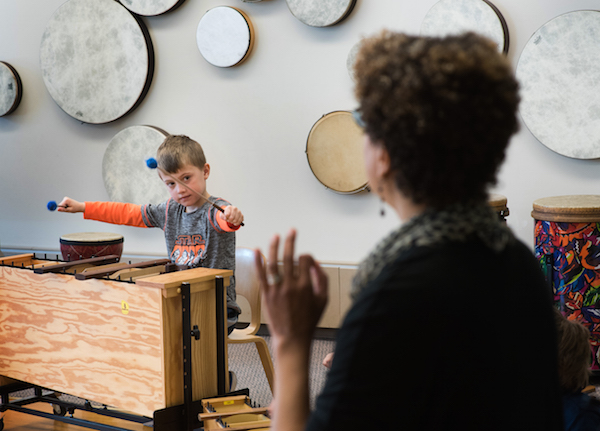By Keisha Hirlinger
One of the most exciting moments when I’m teaching a Lower School music class is when my students are in the driver’s seat and I am there with them to serve as their guide. We start off on this journey together. I give them the tools they need to make good music and a roadmap to the creative process. As they listen and soak up all the information, they soon make the knowledge their own. After that, I watch, wait, guide, learn and see what magic unfolds.
Not long ago, I started a lesson by asking my first grade students to walk around the room while I tapped a steady beat on the temple blocks and repeated a well-known children’s rhyme:
“Simple Simon met a pie man
Going to the fair
Said Simple Simon
to the pie man,
“Let me taste your wares.”
After I repeated the complete rhyme several times, the children began to memorize the stanzas through simultaneous imitation. As each of them felt ready, they began to say the rhyme along with me.
Then, they began to clap the rhythm of the words while continuing to walk around the room, internalizing the steady beat. We added percussion instruments — drums and rhythm sticks — and a second rhyme. We kept building on the complexity until the students were playing four different contrasting parts on a variety of instruments.
This is just one example of the learning that takes place in the Music Room as I work with students in all the Lower School grades. We start small, and over the years, as student understanding grows, we add many more musical elements. The students learn how to create their own arrangements and add introductions, interludes and postludes. Often, while working in small groups, they add movements to accompany their music. Along the way, they discover something that is both fundamental and exciting about music — the possibilities are endless.
Much of what happens in my classroom is steeped in the Orff Schulwerk music education process, which encourages students to learn through listening, imitating, improvising and composing. I’ve found that students learn more through doing and following non-verbal directions than by long streams of instruction. The result is more music-making, less talking, more time to process, listen and create as they ultimately take ownership of the music.
With each lesson, our students engage in this kind of shared learning, where understanding arises out of a collaborative effort by the teacher and student. Students are not seen as empty vessels to be filled, but rather treasure troves of potential and possibility.
As a musician and music educator, I believe that music lives inside every child. My charge is to draw that music out of them, show them its brilliance and possibility and set them on their own course to discovery and creativity.
I am continually inspired and fascinated by the ways in which our students grasp concepts, make them their own and then take off with them in endless creative ways. I see both commonality in their ideas and individuality, which gives me satisfaction and renewed hope about both our shared humanity and our capacity to be independent and uniquely creative individuals.
Music, which has been called the universal language, is inherently social. Our students are encouraged not only to dig deep into their own creativity and learning, but also to collaborate and appreciate that of their peers. We teach them that in an ensemble, every voice matters; even the soloist has an influence and impact on the collective.
This idea of the collective, of the whole truly being more than the sum of its magnificent parts, resonates throughout our community and culture. From the smallest child to the teacher who has served in the classroom for more than three decades, everyone’s voice plays a part in creating our special ensemble. Together, what a song we sing!

